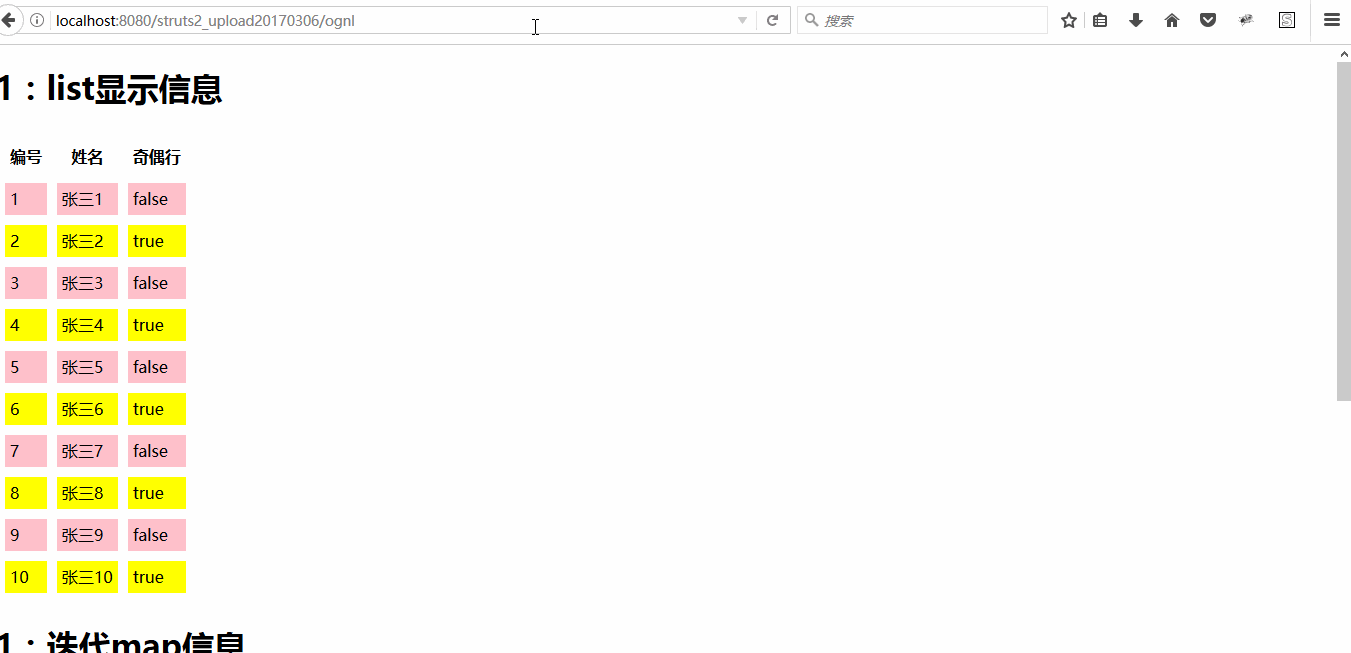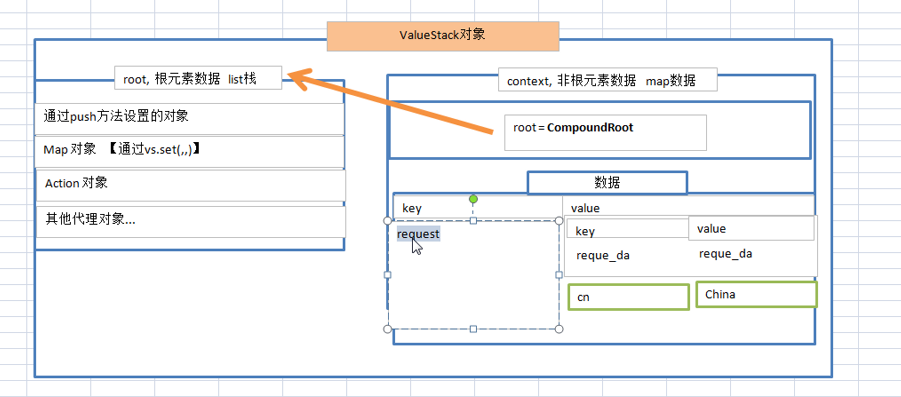OGNL简介:
(1)OGNL是Object Graphic Navigation Language(对象图导航语言)的缩写,它是一个开源项目。
struts2框架默认就支持Ognl表达式语言(所以struts必须引用的包:ognl.jar);
(2)struts2的ognl的作用:页面取值使用;
(3)OGNL和EL的区别:
EL表达式语言:用于页面取值,jsp页面取值的标准(默认可以直接使用,应用范围更加广泛);
OGNL表达式语言:struts2标签默认支持的表达式语言,必须配置struts标签使用,不能离开struts2标签直接使用;
(4)OGNL 有一个上下文(Context)概念,[OgnlContext对象:OgnlContext对象是ognl表达式语言的核心];
其实上下文就是一个MAP结构,它实现了 java.utils.Map 的接口。
(5)ognl表达式语言取值,取根元素的值,不用带#符号;ognl表达式语言取值,取非根元素的值,需要带#符号;
用一个OGNL和struts标签结合的实例演示一下struts的标签的强大功能:
1:第一还是引入struts2核心包,省略
2:创建一个实体类,用于测试显示在页面的信息,如User.java,源码如下所示:
1 package com.bie.ognl; 2 /** 3 * @author BieHongLi 4 * @version 创建时间:2017年3月7日 下午8:45:27 5 * 6 */ 7 public class User { 8 9 private int id; 10 private String name; 11 public int getId() { 12 return id; 13 } 14 public void setId(int id) { 15 this.id = id; 16 } 17 public String getName() { 18 return name; 19 } 20 public void setName(String name) { 21 this.name = name; 22 } 23 public User(int id, String name) { 24 super(); 25 this.id = id; 26 this.name = name; 27 } 28 29 30 }
3:创建完成实体类之后就可以开始开发action,如OgnlAction.java,源码如下所示:
1 package com.bie.ognl; 2 3 import java.util.ArrayList; 4 import java.util.HashMap; 5 import java.util.List; 6 import java.util.Map; 7 8 import com.opensymphony.xwork2.ActionContext; 9 import com.opensymphony.xwork2.ActionSupport; 10 11 /** 12 * @author BieHongLi 13 * @version 创建时间:2017年3月7日 下午8:43:00 14 * 15 */ 16 public class OgnlAction extends ActionSupport{ 17 18 19 private static final long serialVersionUID = 1L; 20 @Override 21 public String execute() throws Exception { 22 //测试迭代标签 23 List<User> list=new ArrayList<User>(); 24 Map<Integer, User> map=new HashMap<Integer, User>(); 25 26 //初始化 27 for(int i=1;i<11;i++){ 28 User user=new User(i,"张三"+i); 29 30 list.add(user); 31 map.put(user.getId(), user); 32 } 33 34 //保存list信息 35 ActionContext.getContext().getContextMap().put("list", list); 36 //保存map信息 37 ActionContext.getContext().getContextMap().put("map", map); 38 39 40 return "success"; 41 } 42 43 }
4:开发完action,配置struts.xml文件,这里使用主次配置,所以这里配置ognl.xml,然后在struts.xml文件中引入ognl.xml配置文件即可:
1 <?xml version="1.0" encoding="UTF-8" ?> 2 <!DOCTYPE struts PUBLIC 3 "-//Apache Software Foundation//DTD Struts Configuration 2.0//EN" 4 "http://struts.apache.org/dtds/struts-2.0.dtd"> 5 6 <struts> 7 8 <package name="ognlpackage" extends="struts-default"> 9 <action name="ognl" class="com.bie.ognl.OgnlAction"> 10 <result name="success">ognl.jsp</result> 11 </action> 12 </package> 13 14 15 </struts>
5:最后书写ognl.jsp显示页面,用于显示信息,源码如下所示:
1 <%@ page language="java" contentType="text/html; charset=UTF-8" 2 pageEncoding="UTF-8"%> 3 <%@ taglib prefix="s" uri="/struts-tags"%> 4 <!DOCTYPE html PUBLIC "-//W3C//DTD HTML 4.01 Transitional//EN" "http://www.w3.org/TR/html4/loose.dtd"> 5 <html> 6 <head> 7 <meta http-equiv="Content-Type" content="text/html; charset=UTF-8"> 8 <title>ognl显示信息的页面</title> 9 10 <style type="text/css"> 11 .odd{background-color:pink;} 12 .even{background-color:yellow;} 13 </style> 14 </head> 15 <body> 16 17 <h1>1:list显示信息</h1> 18 <table cellpadding="5" cellspacing="10"> 19 <tr> 20 <th>编号</th> 21 <th>姓名</th> 22 <th>奇偶行</th> 23 </tr> 24 <s:iterator value="#request.list" var="user" status="us"> 25 <tr class=<s:property value="#us.even?'even':'odd'"/>> 26 <td><s:property value="#user.id"/></td> 27 <td><s:property value="#user.name"/><br/></td> 28 <td><s:property value="#us.even" /></td> 29 </tr> 30 </s:iterator> 31 </table> 32 <h1>1:迭代map信息</h1> 33 <table cellpadding="5" cellspacing="10"> 34 <tr> 35 <th>编号</th> 36 <th>编号2</th> 37 <th>姓名</th> 38 <th>奇偶行</th> 39 </tr> 40 <s:iterator value="#request.map" var="Muser" status="mu"> 41 <tr class=<s:property value="#us.even?'even':'odd'"/>> 42 <td><s:property value="#Muser.value.id"/></td> 43 <!-- 迭代编号的两种方式 --> 44 <td><s:property value="#Muser.key"/></td> 45 <td><s:property value="#Muser.value.name"/><br/></td> 46 <td><s:property value="#mu.even" /></td> 47 </tr> 48 </s:iterator> 49 </table> 50 </body> 51 </html>
运行效果如下所示:

革命尚未成功,OGNL ko , go!!!
6:ValueStack, 即值栈对象(根元素的值存储在root中,非跟元素的值存储在context中)。
(1):值栈对象是整个struts数据存储的核心,或者叫中转站。
(2):用户每次访问struts的action,都会创建一个Action对象、值栈对象、ActionContext对象; 然后把Action对象放入值栈中; 最后再把值栈对象放入request中,传入jsp页面。
(3):(key: struts.valueStack); 开发者只需要通过ActionContext对象就可以访问struts的其他的关键对象。 (ActionContext是给开发者用的,便于学习与使用。)
1 package com.bie.lesson09; 2 3 4 import javax.servlet.http.HttpServletRequest; 5 6 import org.apache.struts2.ServletActionContext; 7 8 import com.opensymphony.xwork2.ActionContext; 9 import com.opensymphony.xwork2.ActionSupport; 10 import com.opensymphony.xwork2.util.ValueStack; 11 12 /** 13 * @author Author:别先生 14 * @date Date:2017年9月23日 上午11:18:51 15 * 16 * struts的数据流转,如何从后台到页面 17 */ 18 public class OgnlAction extends ActionSupport{ 19 20 /** 21 * 22 */ 23 private static final long serialVersionUID = 1L; 24 25 @Override 26 public String execute() throws Exception { 27 //获取值栈对象,方式一: 28 HttpServletRequest request = ServletActionContext.getRequest(); 29 ValueStack vs = (ValueStack) request.getAttribute("struts.valueStack"); 30 31 //获取值栈对象,方式二: 32 ActionContext ac = ActionContext.getContext(); 33 ValueStack vs2 = ac.getValueStack(); 34 35 System.out.println(vs == vs2); 36 37 return SUCCESS; 38 } 39 }
(4)值栈的根元素和非根元素如何存储的关系:

(5)值栈操作根元素和非根元素的如何操作(ActionContext.getContext() = #,取值的时候理解):

package com.bie.lesson09; import java.util.Map; import javax.servlet.http.HttpServletRequest; import org.apache.struts2.ServletActionContext; import com.opensymphony.xwork2.ActionContext; import com.opensymphony.xwork2.ActionSupport; import com.opensymphony.xwork2.util.ValueStack; /** * @author Author:别先生 * @date Date:2017年9月23日 上午11:18:51 * * struts的数据流转,如何从后台到页面 */ public class OgnlAction extends ActionSupport{ /** * */ private static final long serialVersionUID = 1L; // 全局元素,根元素值 private User user = new User(1, "tom"); @Override public String execute() throws Exception { ActionContext ac = ActionContext.getContext(); //映射数据 //ac.getContextMap().put("request_data", "request_data"); // 数据存储request @SuppressWarnings("unchecked") Map<String,Object> map = (Map<String, Object>) ac.get("request"); map.put("request_data", "request_data"); map.put("cn", "China"); ac.getSession().put("session_data", "session_data"); ac.getApplication().put("application_data", "application_data"); // 二、值栈对象的存储数据的原理 ValueStack vs = ac.getValueStack(); /***************操作根元素的几种方法*****************/ // 设置数据: 入栈 // 栈顶 //vs.getRoot().push(new User(2, "jack")); vs.push(new User(2, "jack")); // 移除栈顶元素 vs.pop(); // 如何存储? map结构存储 vs.set("user1", new User(3, "张三")); vs.set("user2", new User(4, "李四")); System.out.println(vs); return SUCCESS; } }
(6):页面获取元素的方法:
1 <?xml version="1.0" encoding="UTF-8" ?> 2 <!DOCTYPE struts PUBLIC 3 "-//Apache Software Foundation//DTD Struts Configuration 2.0//EN" 4 "http://struts.apache.org/dtds/struts-2.0.dtd"> 5 6 <struts> 7 <package name="ognlPackage" extends="struts-default"> 8 9 <action name="ognl" class="com.bie.lesson09.OgnlAction"> 10 <result name="success">success.jsp?userName=${#request.request_data}</result> 11 </action> 12 </package> 13 14 </struts> 15
1 <%@ page language="java" contentType="text/html; charset=UTF-8" 2 pageEncoding="UTF-8"%> 3 <%@ taglib prefix="s" uri="/struts-tags"%> 4 <!DOCTYPE html PUBLIC "-//W3C//DTD HTML 4.01 Transitional//EN" "http://www.w3.org/TR/html4/loose.dtd"> 5 <html> 6 <head> 7 <meta http-equiv="Content-Type" content="text/html; charset=UTF-8"> 8 <title>struts2 hello </title> 9 </head> 10 <body> 11 12 <h1>hello world struts2</h1> 13 14 <h1>${requestScope.request_data }</h1> 15 <h1>${sessionScope.session_data }</h1> 16 <h1>${applicationScope.application_data }</h1> 17 18 <!-- 页面: 必须要拿到ValueStack --> 19 <h1>根元素的值:</h1> 20 <s:property value="user.id"/><br/> 21 <s:property value="user.name"/><br/> 22 <s:property value="user.address"/><br/> 23 <s:property value="user.address.provice"/><br/> 24 <s:property value="user.address.city"/><br/> 25 26 <br/><br/> 27 <!-- 非根元素的值 --> 28 <s:property value="#request.cn"/><br/> 29 <s:property value="#session.session_data"/><br/> 30 <s:property value="#application.application_data"/> 31 32 <br/><br/> 33 <!-- 自动找request/session/application,找到后立刻返回 --> 34 <s:property value="#attr.cn"/><br/> 35 <s:property value="#attr.session_data"/><br/> 36 <s:property value="#attr.application_data"/><br/> 37 38 <br/><br/> 39 <!-- 获取请求的参数数据 --> 40 <s:property value="#parameters.userName"/> 41 42 43 44 <!-- struts的调试标签:可以观测值栈数据 --> 45 <s:debug></s:debug> 46 </body> 47 </html>
1 package com.bie.lesson09; 2 /** 3 * @author Author:别先生 4 * @date Date:2017年9月23日 下午5:20:46 5 * 6 * 7 */ 8 public class Address { 9 10 private String provice; 11 private String city; 12 public String getProvice() { 13 return provice; 14 } 15 public void setProvice(String provice) { 16 this.provice = provice; 17 } 18 public String getCity() { 19 return city; 20 } 21 public void setCity(String city) { 22 this.city = city; 23 } 24 public Address(String provice, String city) { 25 super(); 26 this.provice = provice; 27 this.city = city; 28 } 29 public Address() { 30 super(); 31 } 32 33 34 }





